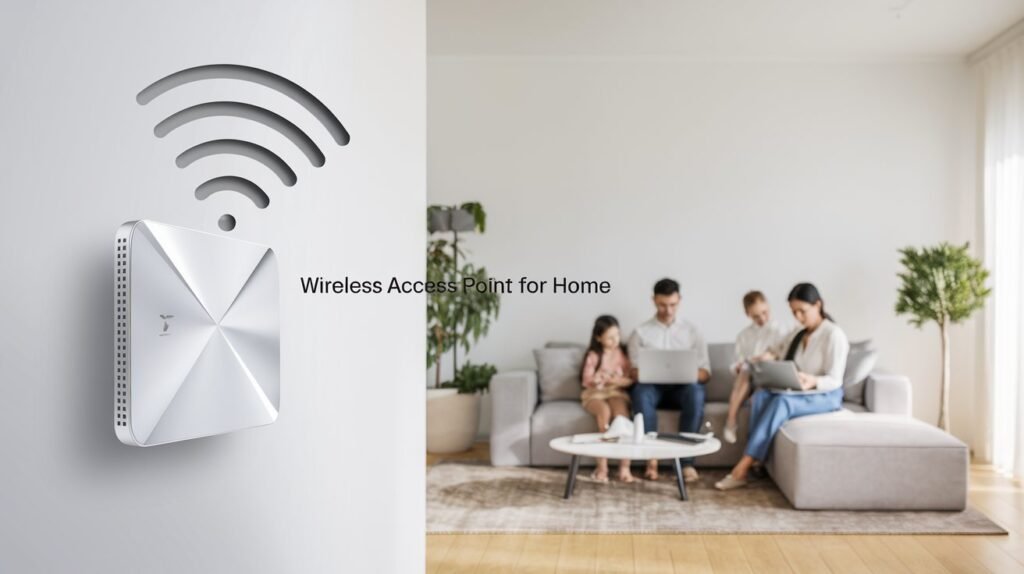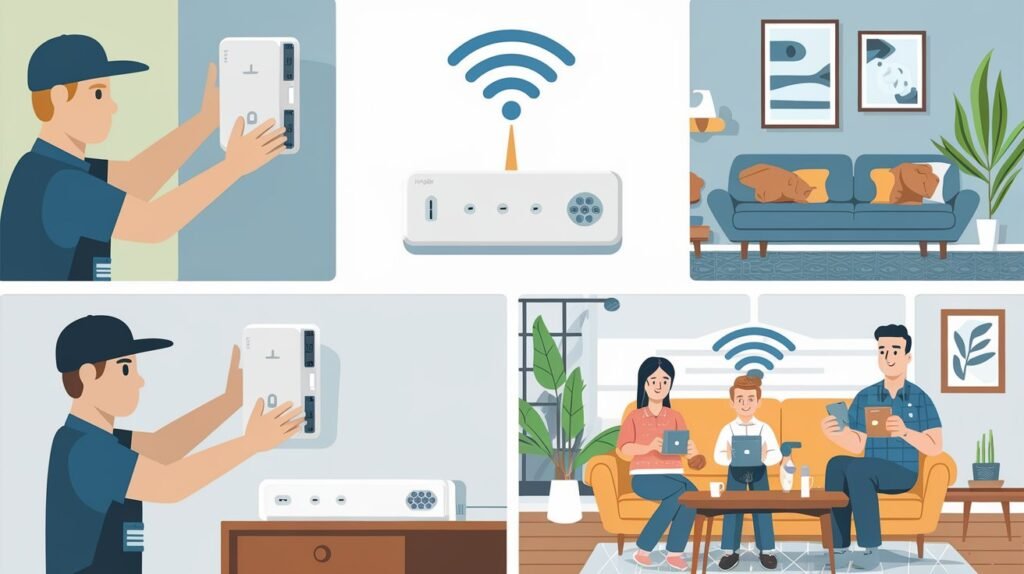A wireless access point for home is essential for ensuring strong, extending internet connections throughout the house without interruption. Dead WiFi zones, many smart devices, or just want to have a proper gaming and streaming experience; all you need to do is find that great access point to work wonders for your network at home. Here, we’ve seen the best wireless access points for home available, their benefits, and how to select on a perfect one suitable for your needs.

Table of Contents
What Is a Wireless Access Point for Home?
A Wireless Access Point (WAP) creates additional points of access to the WiFi signal in the home and connects directly into the main router through an Ethernet cable. Its broadcast WiFi signal makes it easier for devices to connect in areas where the router’s signal is weak.
How a Wireless Access Point Works
- The WAP is directly linked to your router in a wired connection.
- It receives internet data from the router and transmits a new WiFi signal.
- Devices such as smartphones, laptops, and smart home gadgets are instead connected to the WAP, which does not have to struggle with weak main router signals.
Benefits of Using a Wireless Access Point at Home
- Eliminates Dead Zones
- Increases the WiFi coverage to include areas where the signal does not reach or is poor (e.g., the basement or attic), or outdoors.
- Improves Speed and Performance
- Instead of just one router being the source, multiple WAPs act together to create a more robust and stable connection, effectively minimizing lag and buffering experiences.
- Does a great job streaming, gaming, and video conferencing without interruption.
- Supports More Devices
- With a smart home full of connected devices (e.g., smart TVs, cameras, voice assistants), the WAP helps to deliver network traffic efficiently.
- Battery life isn’t affected, especially when many devices crowd a single WiFi connection.
- Enhances Security Features
- Most WAPs provide advanced security features such as guest network, access control as well as WPA3 encryption.
When Should You Use a Wireless Access Point?
- Thus, if you have a very vast home or work space and the signals are quite weak at points, this helps them.
- It is applicable if you wish to join multiple devices without slowing the network.
- If your router does not have any WiFi built in or parameters are very limited in range.
- It is for further improvements of smart homes with device connectivity.
Top 7 Wireless Access Point for Home in 2025
| Rank | Wireless Access Point | Speed | Coverage Area | Best For |
|---|---|---|---|---|
| 1 | Ubiquiti UniFi 6 Lite | Up to 1.2 Gbps | 1,200 sq. ft. | Smart Homes |
| 2 | TP-Link EAP225 | Up to 1.3 Gbps | 2,000 sq. ft. | Large Homes |
| 3 | Netgear WAX214 | Up to 1.8 Gbps | 1,500 sq. ft. | Gaming & Streaming |
| 4 | ASUS AX1800 | Up to 1.8 Gbps | 1,800 sq. ft. | Business Use |
| 5 | Linksys LAPAC1750 | Up to 1.75 Gbps | 2,500 sq. ft. | Multi-Device Homes |
| 6 | Cisco Business 140AC | Up to 1.3 Gbps | 1,600 sq. ft. | Office Spaces |
| 7 | D-Link DAP-2660 | Up to 1.2 Gbps | 1,200 sq. ft. | Budget-Friendly |

How to Choose the Best Wireless Access Point for Home
Selecting the right Wireless Access Point (WAP) ensures you get fast, reliable, and secure internet throughout your home. The following are some of the considerations involved:
1. Coverage Area
- The range of the WAP depends on the size and layout of the home.
- For instance, in larger homes or spaces with thick walls, multiple WAPs may be required or capped with one having an extended range.
- If you were also thinking of outdoor coverage, an external WAP for long-range transmission would be your option.
2. Speed Requirements
- You require different speed levels for different internet activities, that is, streaming, gaming, and video conferencing.
- For 4K streaming and gaming, go for WAPs that support at least 1 Gbps.
- For speed, efficiency, and latency all in one, opt for WiFi 6; also known as 802.11ax.
3. Device Compatibility
- Choose a WAP that supports dual-band (2.4GHz & 5GHz) to ensure compatibility with a wide range of devices.
- 2.4GHz: Longer range but slower speed which is great for home automation equipment.
- 5GHz: Fast speeds but short range, best for heavy usage with lots of streaming and gaming.
- A WAP that supports WiFi 6 should be able to accommodate multiple devices simultaneously, making it better for a smart home.
4. Security Features
- WPA3 Encryption: The latest security protocol to safeguard your network from being hacked into.
- Guest Networks: Visitors can use a separate network which does not permit access to your main devices.
- Parental Controls: Limits access for the children and leads to using time restrictions for the same as well.
People Also Ask
1. What is the difference between a Wi-Fi extender and an access point?
An access point is a networking device that enables wireless networks and devices to connect to it. At the same time, an extender is a networking device that extends the coverage area of your wireless network.
2. Where to put wireless access point in house?
Install your APs in a central location away from any corners, walls, or other physical obstructions to provide maximum signal coverage. Install your APs in a high location to provide the overall best signal strength reception and performance for your wireless network.
3. Can I use a wireless access point at home?
Absolutely, an access point can be used in residential settings, providing wireless connectivity throughout your home.

Factors to Consider When Choosing a Wireless Access Point (WAP)
Here’s a refined table with Features, Best For, Brands, and Examples:
| Key Factor | Features | Best For | Top Brands | Example |
|---|---|---|---|---|
| 1. Power Over Ethernet (PoE) | – Allows the WAP to receive both power and data via Ethernet. – Reduces cable clutter and simplifies installation. | – Users needing WAPs in areas without power outlets (e.g., ceilings, hallways, or outdoor spaces). | – Ubiquiti – Cisco | – Ubiquiti and Cisco access points with PoE support are ideal for professional setups. |
| 2. Ease of Setup | – Comes with mobile apps or web-based dashboards for easy setup. – Features like automatic setup wizards and real-time monitoring. | – Home users looking for a plug-and-play experience. | – TP-Link – Netgear | – TP-Link and Netgear WAPs are known for easy setup and management. |
| 3. Brand Reliability | – Trusted brands offer better performance, longevity, and support. – Reputable brands provide firmware updates and customer support. | – Users who prioritize long-term support and reliability. | – Ubiquiti – TP-Link – Netgear – Cisco | – Cisco for high-end networking solutions. – Ubiquiti for enterprise-grade WAPs. |
People Also Search For
- Best wireless access point for home
- Access point vs router
- TP-Link Access Point
- WiFi Access Point device

Conclusion
Investing in a wireless access point for home is the best way to eliminate dead zones, boost internet speed, and enhance overall connectivity. Whether you need high-speed gaming, seamless streaming, or support for multiple devices, choosing the right WAP can make all the difference.
For professional WiFi connectivity solutions, visit Value Services. Our experts can help you set up the perfect home network tailored to your needs!
Ready to Upgrade Your Home WiFi?
Contact Value Services today and experience fast, reliable, and secure internet in every corner of your home!

